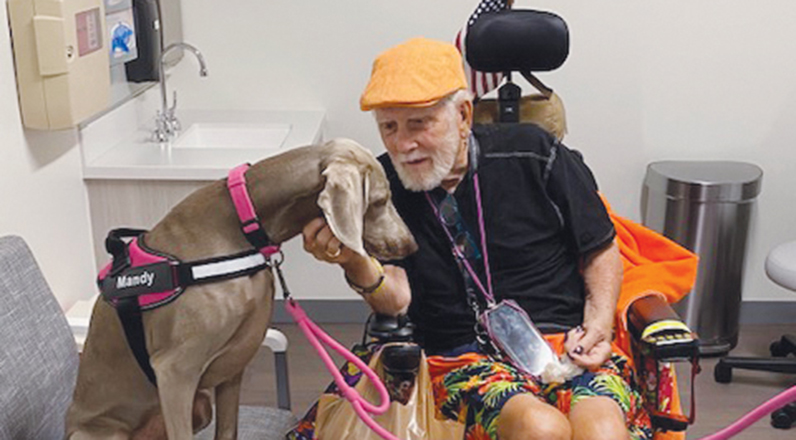
Charles Anderson, a patient of the CARE Center, visits with the center's pet therapy dog, Mandy. The CARE Center is part of Dignity Health St. Mary Medical Center in Long Beach, California. It provides treatment and support to people with HIV or AIDS. Anderson has been a patient since 1999.
Ramon "Ray" Ramirez was an executive at the Marshall's department store chain, privately insured and healthy in the 1990s when his life drastically changed in the mid-1990s. His boyfriend died by suicide, then Ramirez fell ill and was diagnosed with human immunodeficiency virus, or HIV, the virus that can lead to AIDS. His illness progressed to the point that he was unable to maintain his job.
"I found myself ill and alone," he says, "and I discovered I needed help on so many different levels."
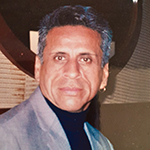
Remembering his boyfriend's positive experience at the CARE Center in Long Beach, California, Ramirez turned to that program for help around 1997. A multidisciplinary team did a full medical workup on him and determined that beyond HIV, he had multiple chronic illnesses. Ramirez says the team helped him address each of the conditions and to maintain a proper HIV medication regimen. Gradually, they helped him rebuild his health.
"If it wasn't for the CARE Center, I don't think I'd have this quality of life," says Ramirez, 74.
Ramirez is one of the approximately 2,000 people assisted annually by the program that Dignity Health St. Mary Medical Center started in 1986 to help people with HIV or AIDS.
HIV used to be a death sentence for those infected. But groundbreaking medical advancements over the past 30-plus years have dramatically improved prognoses and prospects for people who contract HIV, as well as for those whose infection becomes acquired immune deficiency syndrome, or AIDS. The CARE Center has been evolving its programming and services to meet emerging needs during this time. CARE is short for Comprehensive AIDS Resource Education.
Currently, the facility and its staff of about 50 provide HIV/AIDS treatment, medical and dental care, behavioral health, nutrition services, spiritual care, social services and other offerings.
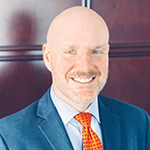
Randy Hope is social services manager and a former patient at the CARE Center. He says, "the goal is to stop transmission of the virus and also with the viral load suppressed, the body is less susceptible to opportunistic infections. Then, people can go from surviving with HIV to thriving with HIV."
'Not who we are'
HIV attacks cells that help the body fight infection, making a person more vulnerable to other infections and diseases. It is spread by contact with certain bodily fluids of an HIV-infected person, most commonly during unprotected sex, or through sharing injection drug paraphernalia.
The body can't get rid of HIV and no cure exists. So, once infected, a person has HIV for life. AIDS, a late stage of HIV infection, occurs when the body's immune system is badly damaged by the virus. Without HIV medicine, people with AIDS typically survive about three years. Once someone has a dangerous opportunistic illness, life expectancy without treatment falls to about a year, says HIV.gov, a website of the Department of Health and Human Services.
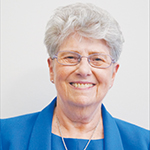
Sr. Celeste Trahan, CCVI, leads St. Mary's founding congregation, the Congregation of the Sisters of Charity of the Incarnate Word of Houston. She says when HIV began spreading in the 1980s, there was much public fear because no one understood why it was spreading so fast, how it was transmitted and why people were becoming so sick. Families were disowning people with the virus and even churches and medical facilities were turning them away. Everyone dreaded infection, Sr. Trahan says.
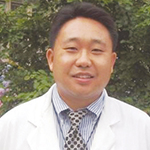
Rev. Stanley Kim, St. Mary mission integration director, says amid the panic a St. Mary social worker told administrators of her concern that patients with AIDS were being turned away from the emergency department with nowhere else to go.
Rev. Kim says the social worker and St. Mary's administrators and the Incarnate Word sisters agreed, "This is not who we are. We do not turn people away."
Comfort care
St. Mary leaders developed the CARE Program, later renamed the CARE Center, to fill the gaping void in care. They sectioned off part of the hospital to take in AIDS patients — many of whom were dying. The CARE Program offered pain management and other palliative care and end-of-life support, as well as home care.
Sr. Trahan notes that a key focus during those early days of the program was building institutional knowledge and understanding of HIV and AIDS and then educating hospital staff and the public with those learnings. The hope was to reduce people's fear and decrease the stigma around infected people.
Around 1987, researchers began introducing drug therapies to inhibit HIV infection and by 1996 researchers had developed a drug cocktail that completely suppressed the replication of the virus in the body, according to the Mayo Clinic. Since then, researchers have been refining drug regimens. Today's medications are so effective that most infected people need only one pill daily to maintain HIV treatment and control.
Boosting immunity
CARE Center's Hope says because of these historic, lifesaving advancements in therapy, the outlook has drastically improved for people with HIV or AIDS. If they adhere to the appropriate drug regimen and maintain habits that boost their immunity and decrease their risk of disease generally, most can live a long, healthy life.
Given these exigencies of life with HIV, Hope says, the center focuses on getting at-risk people tested for HIV, providing drugs that can help prevent infection for exposed people, getting newly infected people very rapidly onto a drug regimen that can decrease the virus' toll and keeping infected people on track with their medications. Infected people need to take their medications all their life, and the medications are very expensive, notes Hope. The center can provide them at no cost for those without coverage.
The center previously had its services spread out around St. Mary's campus but recently consolidated them at a "one-stop-shop" facility. There, patients can get HIV or AIDS treatment as well as other medical care, chronic disease management, dental care, nutrition support and access to a food pantry, counseling and other behavioral care, access to numerous support groups and navigation help with social services. All center staff are trained in providing trauma-informed care. Hope says statistics show that the vast majority of people with HIV or AIDS have suffered trauma in their past, and most also suffer from substance abuse.
Hope notes that much of the center's programming is grant-funded, with some of those dollars coming from St. Mary's foundation. Some of the services the center delivers are reimbursed by private insurance, Medicare or Medi-Cal, which is California's Medicaid program.
Tammy Basile, a registered dietician at St. Mary, is part of the interdisciplinary team that helps CARE Center patients to learn about and maintain healthy habits. She says maintaining proper body composition and boosting immunity is essential for CARE Center patients because if their health deteriorates, they are at higher risk than the general population for very serious outcomes.
Life tools
For center client Ramirez, the positive momentum he built with the health improvements at the center years ago also inspired him to take advantage of the CARE Center's counseling and support groups. In the past, because of social stigma, he had avoided such services. But he says those services helped give him "the tools to live a better life, to listen better, to be more empathetic and to be a better person." He since has returned to the Catholic Church and says he's feeling healthy now, in a holistic way.
He adds that people with HIV or AIDS often isolate themselves and become somewhat reclusive because of fears of contracting diseases and exacerbating their condition. He says the center linked him with people "traveling on the same highway" as him and that helped him form important new social connections.
He says it breaks his heart when he sees people who go to the CARE Center once then never return to become a patient. "I think, 'Your life could be so much better, so much richer.'"
